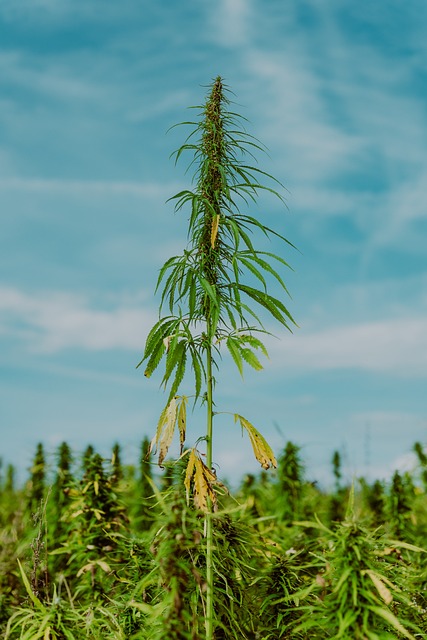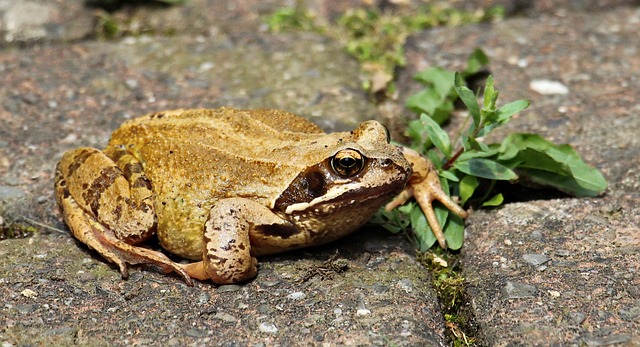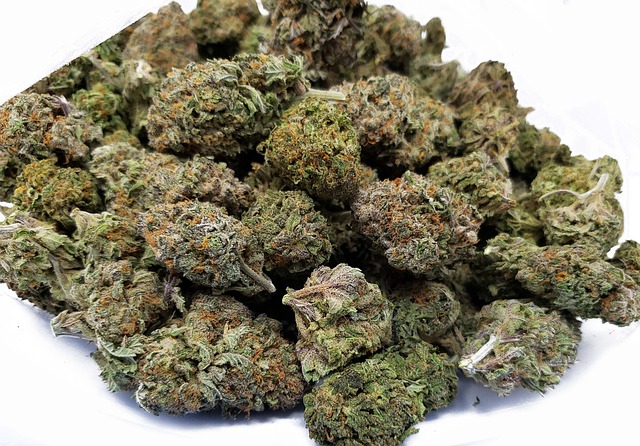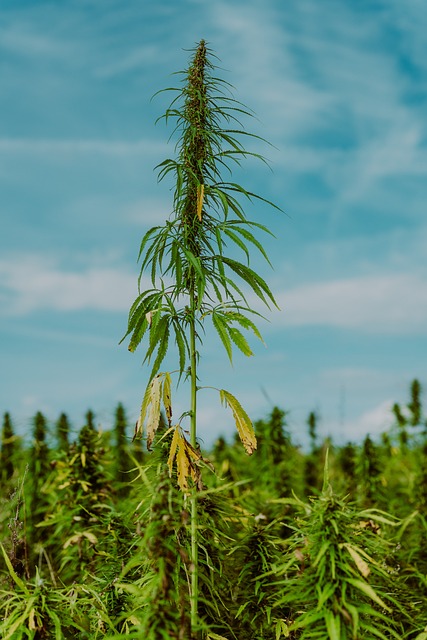Indacloud thca flower, a non-psychoactive form of cannabis, is emerging as a therapeutic alternative due to its potential wellness benefits, which include relaxation and focus. Unlike THC, it interacts with the endocannabinoid system without inducing a ‘high.’ The entourage effect, a phenomenon where compounds like THCA, CBD, and terpenes such as myrcene, limonene, and caryophyllene work together to enhance their effects, is central to its effectiveness. This synergy is critical for optimizing the therapeutic benefits for conditions like pain, inflammation, and anxiety. The unique composition of THCA flower includes over a hundred cannabinoids, with THCa, CBD, and terpenes being most prominent, offering users a multifaceted experience distinct from high-THC or high-CBD products. Its therapeutic properties are increasingly being studied for their potential in natural medicine. The optimal cultivation of THCA flower requires precise environmental controls, careful strain selection, and attention to trichome production and preservation through proper drying and curing processes to maintain its vibrant terpene profile and THCa levels. The therapeutic synergy between THCA, CBD, and terpenes is highlighted as more effective than using each component separately, as evidenced by clinical trials and preclinical studies, positioning THCA flower as a significant option in the realm of natural therapeutics.
Explore the intricate world of THCA flower, a naturally occurring form of cannabis that has garnered attention for its potential benefits and unique composition. This article delves into the distinct qualities of THCA flower, contrasting it with CBD while highlighting the synergistic effects of CBD synergy with terpenes. We will traverse the cultivation practices essential for nurturing high-quality THCA flower, examine the therapeutic properties backed by research, and shed light on how this cannabinoid-rich plant stands out. Join us as we uncover the depths of THCA flower’s potential, from its chemical makeup to its real-world applications.
- Unveiling the Potential of THCA Flower: A Deep Dive into Its Composition and Benefits
- THCA Flower vs. CBD: Understanding the Differences and Similarities
- The Role of Terpenes in Enhancing CBD Synergy within THCA Flower
- Cultivation and Harvesting: Best Practices for Growing High-Quality THCA Flower
- Exploring the Therapeutic Properties of THCA Flower: What the Research Says
Unveiling the Potential of THCA Flower: A Deep Dive into Its Composition and Benefits

THCA flower, the raw, unheated form of cannabis that contains tetrahydrocannabinolic acid (THCa), is gaining attention for its potential wellness benefits and unique composition. Unlike its psychoactive counterpart legal THC flower, THCa possesses a distinct profile that, when decarboxylated, converts into the well-known psychotropic compound THC. In its natural state, THCa exhibits a non-intoxicating nature, offering a spectrum of effects that some users find beneficial for relaxation and focus without the psychoactive high. The flower’s therapeutic potential is further amplified by the presence of cannabidiol (CBD) and an array of aromatic terpenes, each contributing to what is known as the ‘entourage effect.’ This synergy between CBD and terpenes in THCA flower enhances the benefits of each individual component, making it a subject of interest for those seeking natural relief from various ailments.
The composition of THCA flower is rich with over a hundred cannabinoids, but its primary components—THCa, CBD, and a multitude of terpenes like myrcene, limonene, and caryophyllene—are particularly notable for their individual and collective effects. Myrcene, for instance, is known for its sedative properties, while limonene may uplift mood and support gastrointestinal health. Caryophyllene has a unique ability to interact with the body’s endocannabinoid system, offering potential benefits for inflammation and anxiety. The interplay of these compounds in THCA flower not only dictates its effects but also offers a complex and nuanced experience that is distinct from both THC-rich and CBD-dominant cannabis varieties. Users interested in exploring the full potential of cannabinoids may find THCA flower to be a compelling choice, with its diverse terpene profile offering a wide array of benefits that are still being discovered and understood.
THCA Flower vs. CBD: Understanding the Differences and Similarities

THCA flower and CBD are two distinct compounds found in the Cannabis sativa plant, each offering unique benefits and effects. Tetrahydrocannabinolic acid (THCA) is the raw, non-psychoactive form of THC, present in many raw cannabis plants and flowers. Unlike its psychoactive counterpart THC, THCA does not induce a high but is gaining recognition for its potential therapeutic properties, including anti-inflammatory and neuroprotective effects. On the other hand, Cannabidiol (CBD) is renowned for its calming and soothing benefits without the mind-altering impact associated with THC.
The synergy between THCA flower and CBD becomes particularly noteworthy when considering the entourage effect, a phenomenon where cannabinoids, terpenes, and other components of the plant interact synergistically to enhance their effects. The THCA flower’s terpenes can amplify the benefits of CBD by modulating how it interacts with our endocannabinoid system. For instance, myrcene terpenes found in certain THCA flowers may enhance the permeability of cell membranes, potentially increasing the absorption rate of CBD. This synergy can lead to a more potent and balanced experience for users seeking relief from various ailments or wellness benefits. Understanding this interplay is crucial for those looking to harness the therapeutic potential of both compounds. Whether one prefers the subtle effects of CBD or the promising potential of THCA, the interaction with terpenes in cannabis can play a significant role in tailoring the desired outcome.
The Role of Terpenes in Enhancing CBD Synergy within THCA Flower

Delta-9-tetrahydrocannabinolic acid (THCA) flower, in its raw form, presents a unique opportunity to explore the entourage effect, particularly when it comes to CBD synergy with terpenes. THCA, the precursor to the psychoactive compound Delta-9-THC, contains a rich profile of cannabinoids and terpenes that work in concert to modulate various physiological processes. Terpenes, the aromatic compounds found abundantly in cannabis, are known for their therapeutic properties and ability to enhance the effects of cannabinoids like CBD. When THCA flower is consumed, these terpenes play a crucial role in shaping the overall experience by influencing how cannabinoids interact with the body’s endocannabinoid system.
The synergy between CBD and terpenes within THCA flower is particularly noteworthy. Terpenes can alter the pharmacokinetics of CBD, potentially increasing its bioavailability and modulating its effects. For instance, the terpene myrcene is often associated with a sedative effect, which may enhance CBD’s relaxing properties. Similarly, limonene is known for its mood-boosting qualities and can synergize with CBD to provide an uplifting experience. This intricate interplay between cannabinoids and terpenes within THCA flower underscores the importance of a holistic approach when considering the therapeutic potential of this plant material. Consumers seeking the benefits of CBD may find that THCA flower, with its robust terpene content, offers a more effective and nuanced experience compared to isolate-based products. Understanding the role of terpenes in enhancing CBD synergy within THCA flower is essential for anyone looking to leverage the full potential of this botanical’s therapeutic properties.
Cultivation and Harvesting: Best Practices for Growing High-Quality THCA Flower

Cultivating high-quality THCA flower requires meticulous attention to detail and an understanding of the plant’s optimal growing conditions. The journey begins with selecting a robust strain known for its THCA potency, as this cannabinoid precursor to THC offers therapeutic benefits without the psychoactive effects. Ensuring the right balance of light, temperature, and humidity is crucial throughout the flowering stage to promote trichome production, which houses both THCA and the entourage effect-enhancing terpenes. Nutrient management should be precise; overfeeding can lead to undesirable secondary metabolites, while underfeeding may stunt growth. Organic soil with a balanced pH is essential for nutrient uptake and overall plant health.
Harvesting THCA-rich flowers calls for careful timing, as the maturation of trichomes peaks just before the leaves begin to yellow or drop chlorophyll. This timing is key to maximizing THCA content, which degrades into THC upon drying and curing. The harvest process should be handled with care to avoid bruising or damaging the precious trichomes. Drying and curing in controlled environments with low humidity and consistent temperature are best practices to preserve the integrity of THCA and ensure that the terpene profiles remain vibrant, creating a synergy with CBD that can offer a broad range of wellness effects. This synergy is particularly noteworthy as it can enhance the therapeutic benefits of both compounds, providing a more holistic effect compared to using them in isolation.
Exploring the Therapeutic Properties of THCA Flower: What the Research Says

Delta-9-tetrahydrocannabinol (THC) is well-known for its psychoactive effects, but its acidic precursor, tetrahydrocannabinolic acid A (THCA), has garnered attention for its potential therapeutic properties. Recent research indicates that THCA flower, which contains the non-psychoactive THCA molecule, may offer a range of health benefits. Studies suggest that THCA interacts with the body’s endocannabinoid system, potentially influencing pain, inflammation, and anxiety without the psychoactive ‘high’ associated with THC.
The therapeutic synergy of THCA flower becomes even more pronounced when considering its interaction with cannabidiol (CBD) and terpenes. CBD, a non-psychoactive compound found in cannabis, is known for its calming and pain-relieving effects. Terpenes, the aromatic compounds found in cannabis, contribute to the entourage effect, enhancing the therapeutic benefits of both THCA and CBD. This synergy can lead to a more effective and holistic approach to wellness, as evidenced by various clinical trials and preclinical studies that highlight the potential of THCA flower in managing symptoms associated with various conditions without impairment. As research continues to evolve, the role of THCA flower in natural medicine is becoming increasingly clear, offering a promising alternative for those seeking relief from certain ailments.
The exploration into the THCA flower has shed significant light on its unique composition and potential benefits, distinguishing it from CBD. Its interaction with terpenes to enhance CBD synergy is particularly noteworthy, offering insights that could shape future therapeutic applications. Cultivation best practices are crucial for producing high-quality THCA flower, ensuring its efficacy in various wellness regimens. The research underscores the therapeutic potential of THCA flower, promising a new frontier in natural health solutions. As this article has outlined, the THCA flower’s role in health and wellness is an emerging area of interest with promising developments on the horizon.
